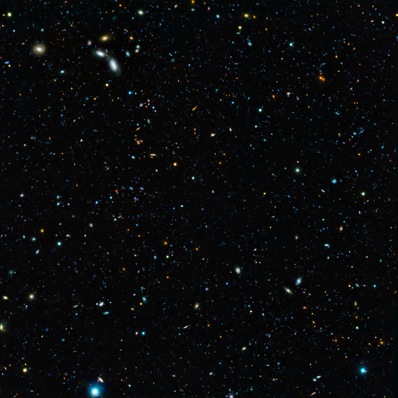
Ninety percent of distant galaxies go unseen
DR EMILY BALDWIN
ASTRONOMY NOW
Posted: 25 March


Using ESO's Very Large Telescope (VLT) and a new, unique camera, astronomers have found that some ninety percent of galaxies 10 billion light years away have gone undetected.
Astronomers frequently use a characteristic of light emitted by hydrogen, known as the Lyman-alpha line, to probe the number of stars in the distant Universe, but had suspected that a large fraction of the total intrinsic light from far away galaxies was not being observed. Their suspicions have been confirmed with a sensitive new survey using two of the four 8.2 metre telescopes that comprise the VLT.

The new VLT survey looked at a well-studied area of the sky known as the GOODS-South field. Image: ESO.
“Astronomers always knew they were missing some fraction of the galaxies in Lyman-alpha surveys,” says Matthew Hayes, lead author of a paper describing the study published in this week's issue of the journal Nature, “but for the first time we now have a measurement. The number of missed galaxies is substantial.”
Hayes and his team used the FORS camera at the VLT, complemented with a custom built narrowband optical filter to measure the Lyman-alpha light in line with other standard surveys using this method. Then they surveyed the same area of space – the well studied GOODS-South field region – using the new HAWK-I camera, which lends itself to studying light emitted at a different wavelength, known as the H-alpha line. H-alpha light is emitted at a wavelength of 656.3 nanometres, whereas Lyman-alpha light is emitted at 121.6 nanometres.
The team specifically searched for galaxies whose light has been travelling for 10 billion years. “This is the first time we have observed a patch of the sky so deeply in light coming from hydrogen at these two very specific wavelengths, and this proved crucial,” says team member Goran Ostlin.
The survey probed depths that Lyman-alpha surveys alone could not attain leading the astronomers to arrive at the conclusion that Lyman-alpha surveys only see a small fraction of the total light that is produced by distant galaxies since most of the Lyman-alpha photons are destroyed by interaction with the interstellar clouds of gas and dust. This effect is dramatically more significant for Lyman-alpha than for H-alpha light, such that up to ninety percent of galaxies may go unseen by these surveys.
“If there are ten galaxies seen, there could be a hundred there,” comments Hayes.
Since strong Lyman-alpha signatures are heavily relied upon to examine the very first galaxies to form, cosmologists must take into account that this view of the Universe is only partially complete. “Now that we know how much light we’ve been missing, we can start to create far more accurate representations of the cosmos, understanding better how quickly stars have formed at different times in the life of the Universe,” says co-author Miguel Mas-Hesse.
|



